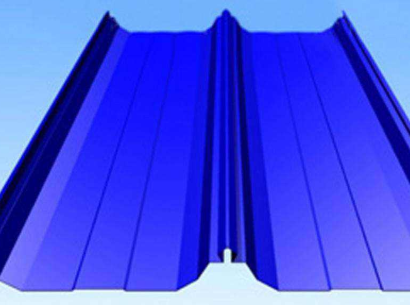彩涂板与镀锌板的防腐功能有什么区别?
天物彩板全国定制配送——更多沈阳彩涂板防腐厂家_沈阳镀锌板价格_请拨打网站上方电话咨询

镀锌板作为一种连续的钢卷生产工艺,可分为镀锌和热浸镀锌两种方法。镀锌方法是在金属表面电沉积一层锌金属或锌合金。热浸镀锌,也称为热浸镀锌,是将受保护的金属产品浸入熔融的zm金属中,在其表面形成保护性金属涂层。与电镀相比,在相同的环境下,铁水镀层更厚,使用寿命更长。
面热镀锌层的腐蚀与纯锌相当。锌在大气中的腐蚀过程与钢在大气中的腐蚀过程相似。化学氧化腐蚀发生在锌表面,水膜冷凝发生电化学腐蚀。
在中性或弱酸性大气环境中,腐蚀形成的镀锌钢板的腐蚀产物是不溶性化合物(氢氧化锌、氧化锌和碳酸锌)。这些产品会以沉淀的形式沉淀,形成一定厚度的致密薄层,不易溶于水、附属物和层,一般厚度可达8um。这种薄膜具有一定的厚度,不易溶于水,附着力强。因此,它可以作为大气和镀锌板之间的屏障,防止腐蚀的进一步发展。当保护镀锌层被破坏,钢的某些表面暴露在大气环境中时,锌和铁形成微型电池。锌的电位明显低于铁的电位。锌起阳极的作用,以保护板基板不牺牲阳极,防止钢板腐蚀。
彩涂板是一种液体涂料,通过刷涂或辊涂的方法在清洁的金属表面上进行涂覆。加热固化后,可获得不同厚度的漆膜。漆膜的作用除了将金属从腐蚀介质中分离出来外,还可以借助于涂料中的一些颜料(如铅锌铬酸盐等)对金属进行钝化,达到永久性的防腐效果。
根据彩涂钢板的防腐机理,有机涂层(包括表面涂层和底部涂层)是一种绝缘材料,它将基体与腐蚀介质分开,以达到防腐效果。
然而,从微观上看,涂层上有许多针孔。针孔是漆膜表面的多孔性缺陷。它们是由于湿膜中的空气逸出造成的。其原因可能是湿膜的表面粘度和气泡壁的界面张力过大。一般情况下,针孔的平均直径为10-10微米。环境中的水、氧等离子可以通过小孔进入膜内,形成局部电池,导致膜下腐蚀。针孔与涂层厚度成反比。也就是说,厚度越薄,针孔越多。
浸没腐蚀的过程(机理)是
(1)水、离子和氧渗入有机涂层。
(2)基体金属与溶液之间的导电路径为电阻较低的涂层。
3)当腐蚀反应进行时,在有机涂层的导电部分下,离子浓度增加,形成固体腐蚀产物。
4)铁的溶解降低了反应部位附近的pH值。
5)阴极区ph值的升高和阳极区ph值的降低对有机涂层有不利影响。
As a continuous coil production process, galvanized sheet can be divided into two methods: galvanizing and hot-dip galvanizing. The galvanizing method is to electrodeposit a layer of zinc metal or zinc alloy on the metal surface. Hot dip galvanizing,
also known as hot dip galvanizing, is to impregnate protected metal products in molten Zm metal to form a protective metal coating on its surface. Compared with electroplating, the hot metal coating is thicker and has longer service life under the
same environment.
The corrosion of hot-dip galvanizing layer on steel surface is equivalent to that of pure zinc. The corrosion process of zinc in atmosphere is similar to that of steel under atmospheric conditions. Chemical oxidation corrosion occurs, and electrochemical
corrosion occurs on zinc surface with water film condensation.
In neutral or weak acidic atmospheric environment, the corrosion products of galvanized steel sheets formed by corrosion are insoluble compounds (zinc hydroxide, zinc oxide and zinc
carbonate). These products will precipitate in the form of precipitation, forming a compact thin layer with a certain thickness, which is not easy to dissolve in water, appendage and layer, generally up to 8um thickness. This kind of film has certain
thickness, is not easy to dissolve in water, and has strong adhesion. Therefore, it can act as a barrier between atmosphere and galvanized sheet and prevent further development of corrosion. When the protective galvanizing layer is damaged and some surface
of steel is exposed to atmospheric environment, zinc and iron form micro-batteries. The potential of zinc is significantly lower than that of iron. Zinc acts as an anode to protect the plate substrate from sacrificing the anode and prevent the corrosion
of the steel plate.
The color coated plate is a liquid coating, which is coated on the clean metal surface by brushing or roller coating. After heating and curing, varying thickness of the paint film can be obtained. In addition to separating metals
from corrosive media, the function of paint film can also passivate metals with the help of some pigments in paint (such as lead, zinc chromate, etc.) to achieve permanent anticorrosive effect.
According to the anticorrosion mechanism of color coated
steel sheet, organic coating (including surface coating and bottom coating) is a kind of insulating material, which separates the substrate from the corrosive medium in order to achieve the anticorrosion effect.
However, from the microscopic point
of view, there are many pinholes in the coating. Pinholes are porous defects on the surface of the paint film. They are caused by the escape of air trapped in the wet film. The reason may be that the surface viscosity of the wet film and the interfacial
tension of the bubble wall are too large. In general, the average diameter of pinholes is 10-10 um. Water, oxygen and other ions in the environment can enter the film through pinholes and form local batteries, resulting in corrosion under the film. The
pinhole is inversely proportional to the thickness of the coating. That is, the thinner the thickness, the more pinholes.
The process (mechanism) of submerged corrosion is
(1) Water, ions and oxygen infiltrate into organic coatings.
(2) The conductive path between matrix metal and solution is the coating with lower resistance.
3) When the corrosion reaction proceeds, under the conductive part of the organic coating, the concentration of ions increases and solid corrosion products
are formed.
4) The dissolution of iron reduces the pH value near the reaction site.
5) the increase of pH value in cathode area and the decrease of pH value in anode area are harmful to organic coating.
